Interesting Stuff
I'm in London for the RCA Degree Show. It's the biggest show ever as they gathered all the departments under one huge tent in the park by the Albert Memorial. I wonder how much of it i'll be able to see. Yesterday evening i managed to get all the information i wanted about only 2 projects before being kicked out of the place by the guys who had to close the place.
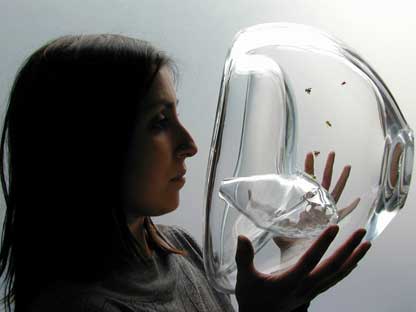
Susana Soares studied bees and in particular the way they can be trained to use their smell and detect pretty anything including bombs and landmines.
Bees are trained using Pavlovâs reflex to target a specific odour and their range of detection includes pheromones, toxins and disease diagnosis. Not only can they roam large distances in search of what you want them to sniff out, it takes only a few minutes to train them, unlike dogs whose training can last up to one year.
Their behaviour can be conditioned by rewards such as sugar-water. They are placed in straw-like containers and made to smell a combination of, say sugar with tiny residues of TNT. That's it! The bees' keen sense of smell will then associate the odour of explosives with food.
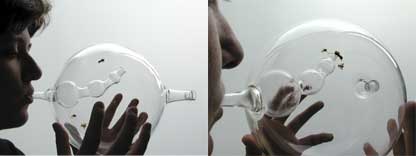
In her BEEâS project, Susana would use the insects as biosensors, harnessing their extroadinary sense of smell to detect diseases such as lung cancer, skin cancer and tuberculosis. Besides they could spot the problem at a very early stage much better than machines. They could even detect if a woman is pregnant which i find much more appealing and elegant than the usual method that involves peeing on a piece of plastic.
The designer visited the London Beekeepers Association and used chewing gum in her tests with the bees. She then located a glass master and had glass objects blown.
People would breathe in the glass diagnosis tools where bees are kept for the short period of time necessary for them to detect general health and fertility cycles. To ensure that the mouth never gets in contact with the insect, there are two different spheres, the bee's smell being strong enough to sniff out what you breathe through glass. Bess would rush into the tubes that lead closer to the breath when they detect any disease they associate with food.
In her scenario, people would receive trained bees by the post (nothing uncommon here apparently), proceed to the breathe test than release the bees.
BEEâS explores how we might co-habit with natural biological systems and use their potential to increase our perceptive abilities. We have always co-existed with these systems, but their potential was unknown.
This project is based on ongoing research that provided the knowledge to enable new interactions.
The aim of this project is to develop collaborative relations between scientific and technological research, beekeepers and design, among others, translating the outcome into systems and objects that people can understand and use, engendering significant adjustments.
 Susana was showing a second project which explores smell as well and forsees the possibility to enhance under-developed (or create) organs of perceptions. Sniffing Others is a development of the Genetic Trace project she exhibited at the interim show, back in February.
Susana was showing a second project which explores smell as well and forsees the possibility to enhance under-developed (or create) organs of perceptions. Sniffing Others is a development of the Genetic Trace project she exhibited at the interim show, back in February.
Smell has become a lost perception:
- in humans the vomeronasal organ regresses during development (in mammals this organ is used to detect pheromones).
- half of our smell receptors have fallen into disuse though if stimulated we could increase our smell perception.
Besides, research has demonstrated that women taking the contraceptive pill decrease their ability to detect odours, prefering genes similar to their own, and eventually choose a mate who is not genetic suitable.
The new organs of perception would allow us to sniff out genetically compatible mates.
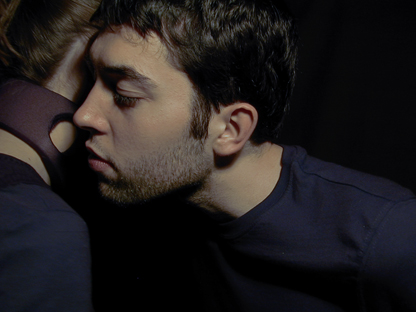
Smell augmentation would be developed gradually through the use of several accessories. Not only new technologies would have to be developed to assist humans in fine-tuning their nose but notions of what is socially acceptable would have to be re-defined. It's not regarded as elegant today to smell the armit of the cute guy standing by you at the bar, right? One of the first step would be to wear the kind of collar shown on the picture above, a kind of sexy accessory that invites your partner to come closer and sniff you. As time passes, people might walk around wearing nose plugs that stimulate the sense of smell, these objects look like delicate pieces of jewellery but later, much later, as human sense of smell is getting stronger, it will be socially acceptable to let long hair grow out of your nose.
- Hz #10 - "Interview with Art Clay, Artistic Director of Zurich’s DAW07"
- Disguise that took the intrepid zoologist into the crocodiles' lair
To get closer to crocodiles, zoologist disguise was a prosthetic head attached to the front of a protective metal cage covered with canvas and a plastering of hippo dung to mask his human scent. - TechnologyReview.fr :: Quand la création artistique s’empare des nouvelles technologies
Les nouveaux modèles de financement de lâart, vus par Stéphane Cagnot - microRevolt reBlog: Conference organizer fails to have Yes Men arrested
Imposters posing as ExxonMobil and National Petroleum Council representatives delivered an outrageous keynote speech to 300 oilmen at GO-EXPO, Canada's largest oil conference, held at Stampede Park in Calgary, Alberta, today. - BBC NEWS | 'Aftershave drink' kills Russians
Russian men are risking death by drinking aftershave and cleaning agents, a study has suggested. - Networked Music Review — Oculog: Playing with Eye Movements
a new system for performing electronic music where a video-based eye movement system is used to control the sound. - … piece 0 plastic - yesmen suggest to turn dead people into oil
in the worst case scenario, the oil industry could âkeep fuel flowingâ by transforming the billions of people who die into oil,â said a Yes Men press release.
Among the Amazonian Desana, all members of a tribal group a believed to share a similar odour. Marriage is only allowed between persons of different odours, so spouses must be chosen from other tribal groups. This belief is expressed in rituals involving the exchanges of goods with different odours: one group will present the other with a gift of meat, for example, and receive fish in return. Some rituals involve the exchange of differently scented ants. The same goes with Batek Negrito of the Malay Peninsula who take the taboo a step further: not only is sexual intercourse between those of similar odour prohibited, but even sitting too close to one another for too long is believed to cause disease in the people involved and in any children they may conceive (via).
Research has demonstrated that humans use body odour to identify genetically appropriate mates.
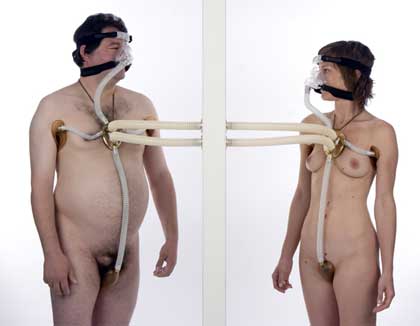
Designer James Auger isa> is working on SMELL+, a project -supported by Philips Design- that will explores the human experiential potential of the sense of smell, applying contemporary scientific research in domestic and social contexts.
One of his proposals is a blind dating agency aimed at individuals wishing to meet a suitable partner for procreation. Olfactory communication is given precidence over visual stimuli.
Related: Susana Soares' exploration of Genetic sexual attraction.
The fun started this morning with the website of the Gas Mask community.
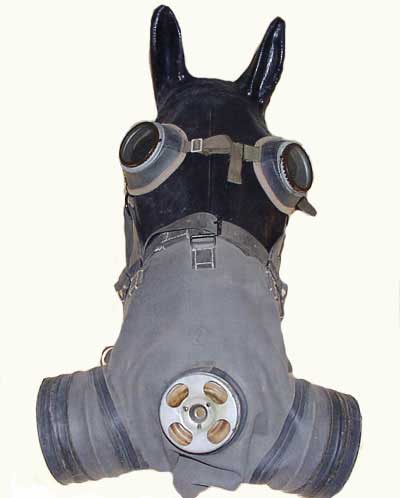
Then i found something for doggies.
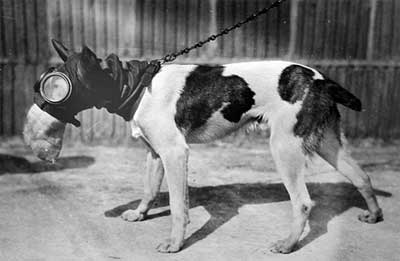
And stumbled upon more pictures in Military Masks Animals in Chemical Warfare and Gas Protection for Animals.
Gas and masks: DIY gas mask, Holocaust installation by Santiago Sierra.
- Moulded connections could improve brain implants
attention-grabbing headline - C1/">Conflux Festival - Call for Conflux Volunteers
to work with the Conflux Festival, taking place in Williamsburg, Brooklyn, Sept. 13-16. Looking for volunteers in a variety of areas: tech support, audio/video/photo documentation, general installation, sales, event staff. - Pentagon once considered building a gay bomb, Sex and Blogs
A 1994 strange U.S. military proposal to create a hormone bomb that could purportedly turn enemy soldiers into homosexuals and make them more interested in sex than fighting. - E-Flux : 'Art and Architecture' - (2007-06-14)
Throughout the summer, 2 exhibitions focusing on art and architecture in Japan and South Africa. Hope i'll be back in Berlin before the end of the summer :-( - Boing Boing: Tarantino's "Penny Dreadful": Steampulp Fiction
- Heat-sensitive urinal stickers as bug spray marketing gimmick
Under dry conditions, the urinal stickers show a housefly in the crosshairs of a rifle scope, but as men take aim and relieve themselves on the stickers, the fly transforms into an advertising message. - Man shot his wife's computer after he found her chatting with men online.
man shot his wife's computer after he found her chatting with men online. Jason Griffith fired a single .40-caliber shot into his wife's computer tower. No one was hurt.
 The bad thing about seeing so many festivals and exhibitions is that i turned into that old lady who's constantly whinging and moaning about the amount of dull or downright crap interactive installations she gets to see. The good side of it though is that whenever i happen to find a really good work, i appreciate it much more than i would have when i was young and fresh to this new media art world.
The bad thing about seeing so many festivals and exhibitions is that i turned into that old lady who's constantly whinging and moaning about the amount of dull or downright crap interactive installations she gets to see. The good side of it though is that whenever i happen to find a really good work, i appreciate it much more than i would have when i was young and fresh to this new media art world.
Yesterday, bliss! I got to play with two such works as the lovely Carlo Vilma was giving me a tour around Les Yeux Ouverts at the Triennale in Milan. The exhibition space has recently invited Fabrica (the Benetton research centre on communication) to mount the show which the Centre Pompidou presented in Paris last Winter.
I had read about the first interactive work several times in the past but never actually got how fun and clever it is until i tested it. Juan Ospina's Flipbook! Deluxe uses a custom-built software application to enable anyone to realize animated clips out of simple line drawings. You create 10 pictures one by one, save them as individual frames and play them back sequentially as an animation.
When you have finished, you can save the film and it will be displayed online or emailed to friends. I could post a link to my awful animation but you might prefer to have a look at something better.
Flipbook! is also exhibited at the Ars Electronica Museum of the Future in Linz.
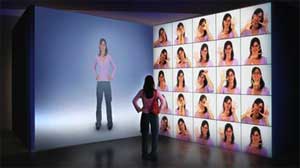 The second installation i really digged is We are the time. We are the famous, by Andy Cameron, David McDougall, Joel Gethin Lewis, Oriol Ferrer Mesià and Hansi Raber. Description: Visitors are confronted by a diptych of two real time images of themselves. One image slows down and blurs time as if it were a photo being developed; the other image fragments time into a sequence of frozen moments, like a strip of cinematic celluloid which appears to move across the wall. On one wall the spectator is encouraged to remain still in order to see his or her image reflected clearly, while on the other one he or she has to move in order to animate the sequence.
The second installation i really digged is We are the time. We are the famous, by Andy Cameron, David McDougall, Joel Gethin Lewis, Oriol Ferrer Mesià and Hansi Raber. Description: Visitors are confronted by a diptych of two real time images of themselves. One image slows down and blurs time as if it were a photo being developed; the other image fragments time into a sequence of frozen moments, like a strip of cinematic celluloid which appears to move across the wall. On one wall the spectator is encouraged to remain still in order to see his or her image reflected clearly, while on the other one he or she has to move in order to animate the sequence.
The still image is in reality a moving image, representing a length of time in motion, while the motion sequence is formed by a series of static moments in time. Time can be seen in two contradictory ways at the same moment. The title of the installation is taken from a poem by Jorge Luis Borges (funny how you never seem to go wrong when refering to Borges.)
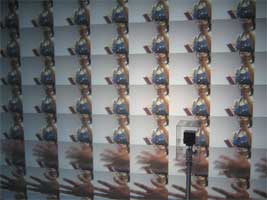
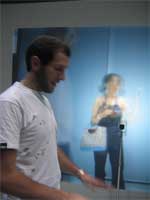
Several reasons why i loved that work. The first one is that the piece doesn't need any explanation label. You enter the space and quickly discover how it works. Second reason is that it resisted well to my slight attention deition deificit disorder. I've learnt to be polite and pretend i'm interested in what i see in galleries but most of the interactive installations don't get my attention for more than half a minute. WATTWATF was awesome enough to keep me immersed for much much longer and i actually came back to the installation three time during my visit. It fills you with a sense of beauty, reacts immediately and elegantly to visitors gestures and playing with your own image is obviously irresistible.
Not interactive but worth a mention:
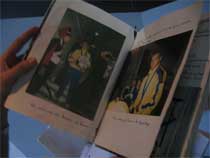
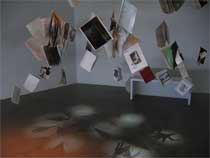
For COLORS Notebook, Fabrica collaborated with Reporters Without Borders and sent blank 30 000 notebooks to people whose voice is never heard: Chinese prisoners, South African children, Canadian priests, astronauts, disabled persons, artists and ordinary people the chance to express themselves without filters or censure. Over 1,000 copies returned to Fabrica, they are covered with words, drawings, paintings, collage, etc. COLORS Notebook is a tribute to a free press and freedom of expression. Some were really gorgeous.
I See, a photo exploration into the current trends of historical, cultural, artistic, social and economic development. Six photographers from Fabrica each picked up a story to represent one of the world's six main geographic areas: North America, South America, East, Far East, Africa and Europe. I liked the Oil Will Never End series by Lorenzo Vitturi who went to Azerbaijan to document the depletion of oil resources in the region.
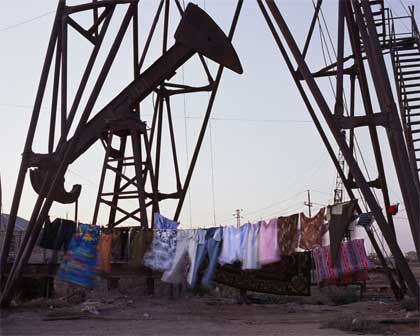
Farbica's Industrial Design section seems to have some really good projects and objects. Wish i'd hear more about them.
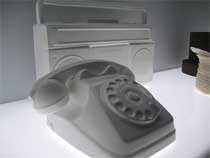
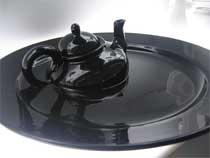
Here's my Flickr set and Oriol's images.
More from Fabrica: Interview of Andy Cameron; Tuned Stairs; Your Pictures, Your Politics.
- taller PEI nuevos territorios en Europa (Barcelona, Madrid, Sevilla y París )
recorriendo la ciudad guiados por Carlos Hernandez sino que realizaran talleres en cada una de las ciudades que visiten con reconocidos Arquitectos Artistas y Diseñadores - ::. Sónar .::. Art Digital a la Carta
- networked_performance: SIGGRAPH Unraveled 2007
Submitted works should be functional and able to be withstand some level of demonstration. Deadline to submit work is friday. - Wishful Thinking » PSFK Conference - Morning
If youâve not seen WMMNA yet, you might not want to - itâs fascinating but not for the squeamish, a kind of avant-garde version of PSFK, tracking emerging trends in art and technology. E.g. Todayâs top post is part of a series on Future Body Parts, - Tate | Online Events | Rafael Lozano-Hemmer: Artist's Talk
- Super Mural en Bloques prefabricados de Berlín at edgargonzalez.com
being away from berlin suxxxxxxxx - Pixelache festival » Alejandro and i
Talleristas in Colombia - Welcome to Spamradio - Spamradio
we turn the junk mail that we receive into a streaming audio broadcast that can be enjoyed from anywhere on the Internet.
- E-Flux : Thermocline of Art. New Asian Waves
117 artists representing 20 countries from the Middle East to Far East, from Southeast Asia to Near East and Central Asia, offers the first comprehensive picture of contemporary Asian art production. - Boing Boing: YouTubes to make your Mexican grandmother cry
video clips from the "golden age" of Mexican popular music: boleros, rancheras, huapangos and rumbas from artists who were popular from the '20s through the '50s. - Archinect : Google Spy
With google streetview vans out there, one better think twice before entering a cannabis club, standing in front of a strip club, sun bathing, picking your nose, or urinating in public. - Could luggage-free airports help avoid holidays from hell? | the Daily Mail
nstead of dragging their suitcases to check-in, passengers would pay to have their baggage picked up from home and delivered independently to their destination. - Cyber warming: PCs produce same CO2 emissions as airlines
Task force to launch an attempt to reduce "cyber carbon footprint" - which threatens to wreck attempts to hit targets for reducing emissions of carbon dioxide, and to encourage the spread of "green" technology. - a rise in organised crime gangs that profit by collecting household and business waste before dumping it illegally
The gangs set up "front" companies to collect waste before leaving it in unauthorised landfill sites, littering the countryside, or sending it abroad. - Solid staolid state no logic - Disco singing and choreography.
Paul Granjon singing Born to be alive. this is soooo french - 3xL : Bizarre Rubber Play!
Ever wanted to wear piss pants to a fetish party and never have to worry about going to the bathroom all night? - Twenty-First Century Cities - Forbes.com
orbes special on 21st century cities - Kiss And Makeup: Brand New You Tube cosmetics!
You Tube beauty products, haha! - Eye-Tracking Device Lets Billboards Know When You Look at Them
video camera surrounded by IR Leds can record eye contact with 15-degree accuracy at a distance of up to 33 feet. A glance from a passerby scores an impression, providing a tally that enables new Google-like measurement metrics that real-world advertisers - Communist Pesticide Contaminates Building: Suicide Sparks Poison Scare
A 48-year-old man has killed himself by spreading a powerful communist-era pesticide in his flat and breathing in the fumes.
In Bohdi Obfuscatus (Space Baby) American-born Korean artist Michael Joo borrowed a Korean Buddha from a local shrine and encased it in a halo of video cameras. Paying homage to Nam June Paik, Joo created a kind of televisual feedback loop, with the Buddha's image being transferred to video monitors all over the room (via.)
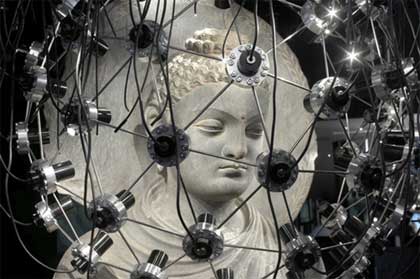
More images of Joo's works: 1 and 2.
- UK smoke ban reveals stink at club
cigarette smoke masks body odour and the smell of stale beer, vomit and toilets. Club has installed fragrance systems which pump out smells including strawberry, chocolate and vanilla. - Gridskipper, Vegetarian Fast Food in Berlin
- Robot Gossip: Robot Mushroom Picker
Warwick HRI, have designed a robot to help mushroom farmers. Robot finds only perfectly ripe mushrooms and gently picks them with a suction cup and quick twist of the wrist. - Entretien avec Oron Catts - ARTE
Jens Hauser interviews Oron Catts - Entretien avec Peter Singer - ARTE
;br/> Le philosophe Peter Singer compte lui aussi parmi les sympathisants des bio-artistes australiens du «Tissue Culture & Art Project». - L'Observatoire de la génétique - Quand l'art se fait chair
Les bioartistes décomposent les êtres vivants, sondant comme par miroir les démarches biotechnologiques. Ils jouent avec la peau, le cÅ"ur des grenouilles, des ovules, des papillons, lâADN et des amas cellulaires. - L'interview de Steve Kurtz - ARTE
- Tate Modern | Symposia | Disrupting Narratives
international symposium brings together some of the world's leading media artists, theorists and researchers to explore real-time interaction in electronic media
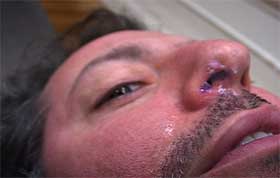 In Adam Zaretsky on Future Body (part 1), i was focusing on the talk that Adam gave in Edinburgh a couple of weeks ago. But i thought that i should also blog some of the projects he mentioned in Scotland.
In Adam Zaretsky on Future Body (part 1), i was focusing on the talk that Adam gave in Edinburgh a couple of weeks ago. But i thought that i should also blog some of the projects he mentioned in Scotland.
Let's start with the image on the left. That's a close-up of Adam whose nose had just lost its virginity. It all started with Julia Reodica's hymNext Project.
In clinics around the world, performing hymenorrhaphy or hymen replacement is a very lucrative venture. Reodica's project is somewhat different. She grew in a petri dish and sculpted unisex hymens with living materials and her own body cells into a variety of designs for application on the human body (like Adam's nostril.) Human fibroblasts, derived from newborn male foreskin and female vaginal cell lines are also incorporated into hymen production.
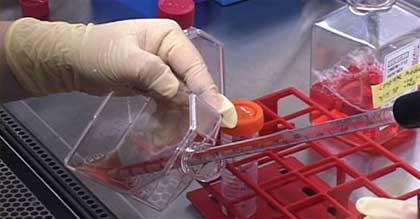
Cells cultured and integrated within bovine collagen that acts as scaffolding material for cell growth
The hymens symbolize the complicated yet, creative relationship between artists and scientists. They also challenge social expectations of female and male sexuality. The membrane has historically been a male instituted tool of surveillance upon the female to ensure her chasteness before becoming the property of her husband. Today, the female social and professional status haven considerably risen and so standards of what is deemed acceptable female behavior should also evolve.
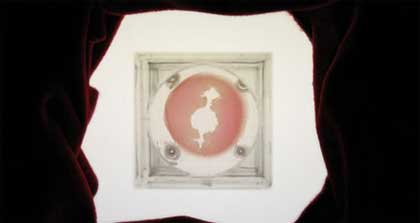
Hymen sculpture at 2 weeks
The hymen performance wasn't the first collaboration between Adam and Julia Reodica. In 2002, they performed The Workhorse Zoo, a kind of multispecies Big Brother. Adam Zaretsky and a bunch of lab creatures spent a week in a transparent terrarium under the eyes of gallery visitors and a non-stop web cam. His little companions included E. Coli bacteria, worms, plants, Zebra(fish), albino frogs, mice, flies and yeast. Each of these organisms is usually treated and separated aseptically in lab experiments.
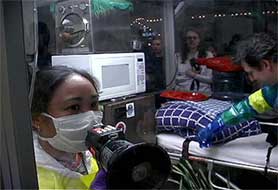
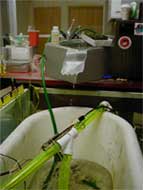
Inside the terrarium animals were eating, reproducing, hunting and were hunted. The performance attempted to reveal some of the more contentious ethical issues that humans face when interacting with other lifeforms.
Julia Reodica, who was Zaretskyâs teaching assistant while he was a visiting professor at San Francisco State University, was handing a quiz that asked spectators to question where they stand on issues surrounding food, death, animal research and entertainment.
Continue reading...
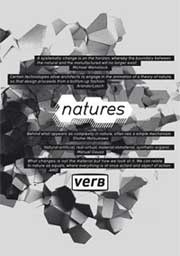 Verb Natures (Amazon USA
Verb Natures (Amazon USA and UK
), edited by: Albert Ferré, Irene Hwang, Tomoko Sakamoto, Ramon Prat, Michael Kubo, Mario Ballesteros and Anna Tetas.
Editor's blurb: âWhat is fascinating is the inability to separate the real from the digital, because they already form part of the same nature.â So we said in the last issue of Verb. Here we explore how this fusion takeson takes place. Buildings and cities grow, are transformed, and dissolve. How can this evolution be generated, controlled, enhanced or imagined? Is our environment programmable? How does the fusion of natural and artificial matter produce new architectural organisms, new environments, new natures? How does technology animate space, and how do users and programs animate matter? The fifth volume of Actar's boogazine looks for a new definition of the organic.
A "boogazine"? It's a hybrid volume designed to combine the flexibility of a magazine with the depth and format of a book. Published since 2002 by Barcelona-based editor Actar, each of the boogazines explores a specific aspect of current architectural production.
I wish they had kept the book habit to write a few lines about the editors.
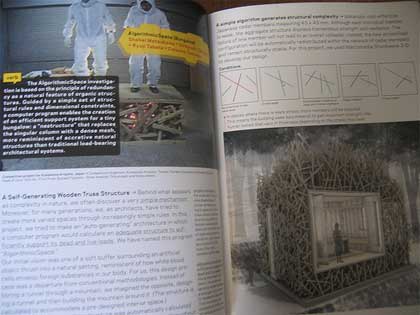
The AlgorithmicSpace
Don't be fooled by the term "natures". Here, the "natural" often looks supernatural and its realization is most of the time informed by algorithms, strict geometry rules and other mathematical processes. The book is thus quite techy but even i could understand what the techniques are about. I found that it was actually the strong point of the book: the many images, graphics, interviews with the designers, researchers or architects and clear explanations of the vocabulary and building strategies made me feel very smart. I managed to get a deeper understanding of construction and design processes which i would otherwise find too arcane and sophisticated.
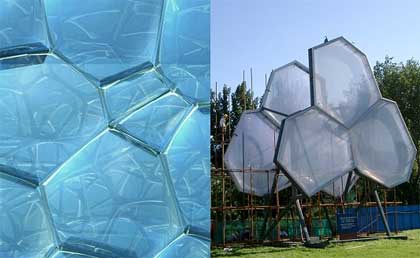
Beijing's Watercube (more images)
The book focusses on over 20 projects, some are ueber-famous, others were new to me. I was particularly happy to get more insight on the Beijing National Aquatics Centre (nicknamed "the watercube") or R&Sie fabulous Dusty Relief in Bangkok. The book goes beyond buildings and looks at interactive rooms (Ada in Zurich), ports (Fugee Port in Taiwan), the artificial reconstruction of a natural mountain (the Dénia project on the Spanish coast) but also design projects such as Clemens Weisshaar & Reed Kram's Breeding Tables which were launched 2 years ago (and with much press coverage and public wonder) at the Salone del Mobile in Milan. Oh, yeah! and there's even some arty projects like the Brooklyn Pigeon Project.
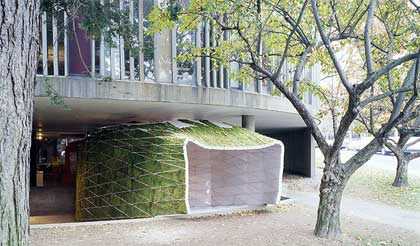
The Puppet Theatre (Images)
A few years ago, architects Benjamin Aranda and Chris Lasch decided to record New York from the perspective of the movements of a flock of birds. They equipped pigeons with wireless video cameras and microphones, turning them into satellites that fed images and sounds of the city below. As the architects explained in an interview for the book "In conventional satellite and aerial mappings of the earth, an enormous amount of effort is dedicated to squeezing out any trace of movement from the image and even from the environment." (...) "So by reintroducing time into the map ours is in some ways a more accurate depiction of the world. But funny enough, this doesn't make it any better map."
They equipped pigeons with wireless video cameras and microphones, turning them into satellites that fed images and sounds of the city below. As the architects explained in an interview for the book "In conventional satellite and aerial mappings of the earth, an enormous amount of effort is dedicated to squeezing out any trace of movement from the image and even from the environment." (...) "So by reintroducing time into the map ours is in some ways a more accurate depiction of the world. But funny enough, this doesn't make it any better map."
More in this video intro and interview.
While in Paris i checked out Airs de Paris, an exhibition that runs until August 15 at the Centre Pompidou. The show is really good. Looks a bit like one you could see at the Palais de Tokyo. Except that you are not allowed to take pictures, people don't seem to have as much fun, the gadget shop is bigger and less tempting. But that's just trifle and i'll come back to the exhibition soon.
I headed there after having read on variable environment that Philippe Rahm had installed a room called Diurnisme.
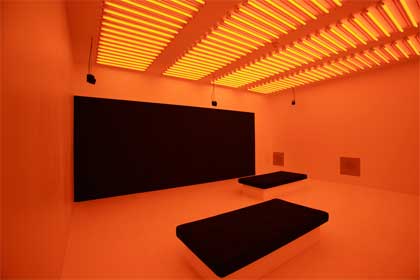
The introduction of the street lighting in the beginning of the 19th century has wipped out the day/night rythm from the city. With street lighting emerged new behaviors, such as noctambulism, sauntering the evening on the boulevards, dancing in the balls.
Rahm put the idea upside down by trying to introduce the night during the day. Itâs a perverted answer to the perpetual day created by the modernity, Internet and the contemporary globalization. The room is bathed in a very bright orange/yellow light which wavelengths, upper than 600 nanometers, are perceived by the body as the night. The paradox is caused by the fact that our perception of day and night is guided by a hormone called melatonin. The peculiar light of the room triggers the production of melatonin, fooling the body into thinking that it is nighttime.
Verdict: it does work. I felt a bit sleepy in there and some people were having a nap on the benches. The music might help too, as speakers were broadcasting 18 Diurnes, some inversions of a composition written by John Field, known for being the first composer to write nocturnes.
Arte has some interviews in french of Philippe Rahm.
Photo: © photo Adam Rzepka, Centre Pompidou.
Related entries: Responsive Environments: Architecture, Art and Design; Christophe Guignard's talk at LIFT07.
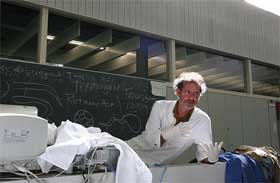 I'm now spending a week in a super boring city. That's the best way i found to catch up with blogging, writing articles for paper mags and working on my own projects.
I'm now spending a week in a super boring city. That's the best way i found to catch up with blogging, writing articles for paper mags and working on my own projects.
First long overdue post is about a fantastic guy whose work i've been admiring for some time. He's called Adam Zaretsky and we met in Edinburgh where New Media Scotland had invited us to discuss the Future Body at the Poker Club.
Zaretsky is a teacher and practitioner of VivoArts, an emerging and politically charged field that brings together art and biology. He has been lecturing and doing research in some of the most prestigious institutes around the world and he is currently teaching at the University of Leiden (NL).
His Vivoarts: Biology and Art Studio course explores five areas where art meets biology (Ecology and EcoArt, Gastronomy and Edible Art, Biology and Bio-Art, Ethology and Art for Non-humans, Physiology and Body Art) and discusses cultural issues such as gene patenting, population diversity (he imagines that we could one day create jellyfish people who'd be floating around the city), new reproductive technologies, nature/culture boundaries, etc. The ethics of living art production are debated and made more tangible and understandable by the use of living material/organisms into the class final projects.
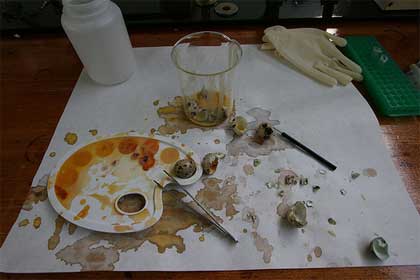
A hands-on approach is crucial to him. Adam believes that without getting your hands "dirty" you can't fully assess the relationship between safety, aesthetics and responsibility implicit in this field. What happens inside a lab is not as squeaky clean as we'd imagine. For example:
 In one of his workshops, Zaretsky has students or participants "paint" with genetically modified bacteria (image on the right); in another, they can incorporate themselves into a work of living art. The idea is to let them see how they can insert their own fantasy and desires right into the genome.
In one of his workshops, Zaretsky has students or participants "paint" with genetically modified bacteria (image on the right); in another, they can incorporate themselves into a work of living art. The idea is to let them see how they can insert their own fantasy and desires right into the genome.
Participants are asked to extract and isolate Hybrid DNA which is found in all living cells. Varieties of samples can be collected from food, pets, pests, human bodies, laboratories and free or not so free living portions of the outdoors. The DNA samples of living, growing, raw or recently alive materials are isolated --using products such as soap, contact lens solution, Woolite-- and put in a blender: vegetable, human, animal, fungus, mold, bacteria, dirty underwear or whatever is alive or uncooked.
In his Leyden class he recently had students create transgenic phaesant and quail embryos. Yes, he's allowed to do that because as he says:
The embryos cannot be allowed to live too long nor can they be inserted into a womb. But stillut still, there's much to learn in the process, like following the development of the embryos and reflecting on the fact that they have no rights (Adam even labelled some eggs with names such as "sub-human", "non-being", "loss and lack", etc.) doesn't imply that they are not living and growing beings to which one can give an imprint. At the end of the process he has students choose the way they want their embryo to be killed.
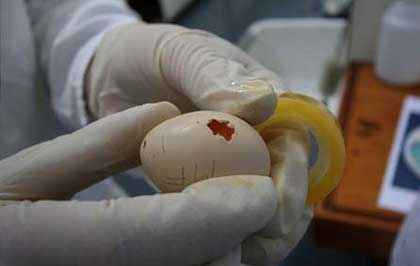
I wish i'd have been fast enough to write down every single witty quote from Adam. Explaining how wild future developments might go he mentioned that
Photos from the Transgenic Pheasant Embryology Lab, credits to Jennifer Willet from Bioteknica.
Last year in early July, i was totally fed up with art, technology, festivals and talks. Only thing i was dreaming about was reading crime stories while eating my own weight in chocolate and figs. Yet, in mid-July i flew to Huddersfield to attend another new media art conference. Its name was We Love Technology and surprise, surprise, i found it nearly as exciting as a novel by Minette Walters combined with a box of Marcolini.
This year Lisa Roberts and her team at BLINK are busy preparing the second edition of We Love Technology. The event will take place on July 12 and people like Andy Gracie, Mirjam Struppek, Mathias Fuchs, Usman Haque, Julius Popp, have been invited to talk about interactive architecture, sound and games. The best thing about WLT is that the gathering is small enough to allow every participant to get to know the others over the picnic, workshops, performances and breaks (i think you can still get some entries.)
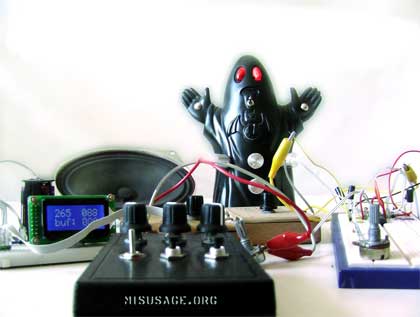
I asked Lisa to tell us more about WLT07:
You're organizing for the second time "We Love Technology" in Huddersfield. Why Huddersfield? Why should people interested in tech-art put the city on their map?
Huddersfield is a big town with equally big ideas and a distinctive and active new media scene. It hosts The Digital Research Unit which is packed with sound artists, games hackers and performers, designers and technologists who generally mistreat and reappropriate technologies.
There is also a 3 month artist-in-residence programme for international artists. They take their experience of Huddersfield with them but often maintain their link through successful partnerships, as in the case of Dan and Tuomo and Tile Toy.
This year WLT will explore interactive architecture, sound and games. What made you choose these particular fields? What do they have in common?
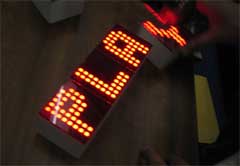 Just to get the ball rolling I chose loose themes from the latest, most interesting and active areas of creative technology, but more than anything I try and bring together a good mix of entertaining speakers who are willing to share their ideas. I have learnt not to over-engineer events as a bit of edginess keeps people from dropping off, especially after lunch. You also have to remember that most of the people who come to WLT will get more ideas from 30 mins of web surfing than 3 days of formulaic conferencing. So it's important to keep it moving along.
Just to get the ball rolling I chose loose themes from the latest, most interesting and active areas of creative technology, but more than anything I try and bring together a good mix of entertaining speakers who are willing to share their ideas. I have learnt not to over-engineer events as a bit of edginess keeps people from dropping off, especially after lunch. You also have to remember that most of the people who come to WLT will get more ideas from 30 mins of web surfing than 3 days of formulaic conferencing. So it's important to keep it moving along.
Last year was the first edition of WLT. What have you learnt from last year that you will definitely repeat this year? And what will you avoid this time?
It can get very warm in July so you need to give everyone plenty of opportunity to break out, breathe and discuss the good stuff in a mix of outdoor spaces. We hope to keep in the picnic element that went down so well last year. I really wanted to showcase some of the great audio performance stuff happening now so the evening session has extended to include some very special drumming from derehctub's Jaxson Payne.
I suppose the main change is that WLT07 is enveloped by a series of three-day hands-o hands-on technology DRU workshops where you can learn how to build electronic instruments, take a walk through environmental microbiology networks and modify computer games software.
Join us!
I couldn't fly to New York to pick up the we-make-money-not-art Webby award. So i asked the cutest guy i could think of to do it for me.
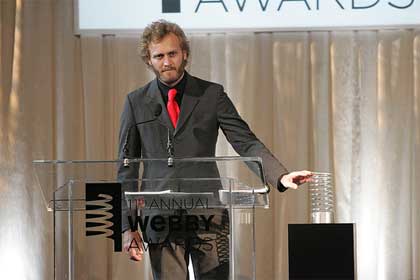
Of course it helped that he had to be there anyway to fetch his company's award. Thanks again Nicolas.
Just back from Madrid where the festival PhotoEspaña is on until July 22. Didn't see everything, i just grabbed a programme and went blindly from one gallery to another.
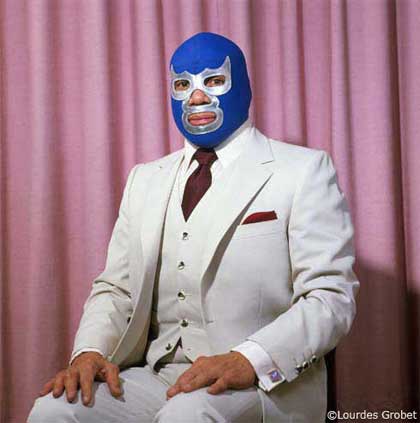
Lourdes Grobet is showing the photos she has been taking for 25 years of Mexican luchadores.
The show is at the Casa America. Mini photo gallery.
If you're in Madrid, my recommendation for the weekend is Medialab Madrid. They've been running a workshop on Magic and Technology and will be showing the results this Saturday, at the Centro Cultural Conde Duque.
Related: Lucha Loco.
Anna Dumitriu is the Director of the Institute of Unnecessary Research and an artist whose work is deeply grounded into scientific research. I met her a few weeks ago at the Mobile Music Workshop in Amsterdam where she was presenting Bio-Tracking, a mobile phone based exhibition using GPS and a software called Socialight which enabled the placement of virtual sticky notes around various locations in Brighton.

Anna sampled various locations in the city for bacteria and moulds, revealing this unseen world to us through digital micrographs. Luciana Haill, Ian Helliwell Ollie Glass and Juliet Kac created a series of sound works to accompany the images. Microbiologist John Paul wrote scientific text descriptions of the microbes.
The use of GPS, to map the locations where the microbiological swabs were taken, brought together the microscopic and the macroscopic, drawing a thread between the satellites orbiting the earth and the bacteria at our feet.
Visitors could download the software and wander around the sites receiving SMS, sound files and images to their phones. Due to the nature of Socialight the exhibition is still live and can be viewed now.
I was so impressed by Anna's enthousiasm and the sense of poetry she brings to an invisible world which i would otherwise find as exciting as a citrus juicer that i asked her to give us more details about her work:
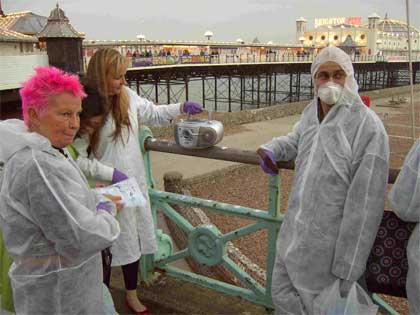
The Bio-tracking Walk Source
How did you get interested in bacteria?
I've always been fascinated with microscopic forms, I think from childhood, but about 12 years ago a key area of research for me was the notion of immortality, that led me to an interest in cell biology, looking at immortalised cell lines such as HeLa Cells and I was invited to do a short residency at St Georges Hospital in London in their Clinical Genetics lab, I became increasingly interested in the differences between our media generated notions about science and the deeper story we don't normally get to hear about. The world of normal flora microbiology is really astonishing, to me it's sublime, there are more bacteria on the end of your finger than there are people in the world, I can't really get my head around that.
You told me (if i remember well) that you collaborated with scientists to develop your project. How do you think they perceive your work? Were they interested in your experiments?
Microbiologists seem to love my work because I am studying the things that they don't get to study. You don't become a microbiologist without the same fascination that I have for the microbial world but because of funding and other restrictions they aren't able to study the normal flora. Clinical Microbiology studies that 1% or so of bacteria that can make us ill, the ones I study are considered to be 'of no commercial or medical interest', it's the needle in a haystack thing, there might be something in that haystack worth looking scientifically at but you'd have to go through a huge amount of hay first, it won't produce the quick results or the scientific papers needed to secure funding.
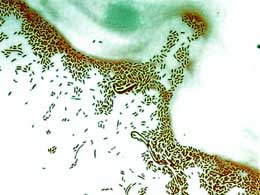 Epistemologically it's an interesting issue, where do we draw the line about what is studied? Money draws that line. But art is judged in other ways by funders, a questioning of our epistemology can be an important issue, the aesthetics of the work, the way the public is engaged is important (in terms of Arts Council England who fund alot of my work), so I can be funded to look at this area as an artist. In terms of scientific support I've been working with Eastbourne District General Hospital (through Arts in Healthcare) and The Royal Sussex County Hospital in Brighton as well as a number of other collaborators and institutions. The use of digital media is also important to me (I'm looking at looking computer modelling of bacteria and artificial life technology) and I am currently Artist in Residence at The Centre for Computational Neuroscience and Robotics at Sussex University, one of the leading Artificial Life research groups in the world, which is an amazing experience.
Epistemologically it's an interesting issue, where do we draw the line about what is studied? Money draws that line. But art is judged in other ways by funders, a questioning of our epistemology can be an important issue, the aesthetics of the work, the way the public is engaged is important (in terms of Arts Council England who fund alot of my work), so I can be funded to look at this area as an artist. In terms of scientific support I've been working with Eastbourne District General Hospital (through Arts in Healthcare) and The Royal Sussex County Hospital in Brighton as well as a number of other collaborators and institutions. The use of digital media is also important to me (I'm looking at looking computer modelling of bacteria and artificial life technology) and I am currently Artist in Residence at The Centre for Computational Neuroscience and Robotics at Sussex University, one of the leading Artificial Life research groups in the world, which is an amazing experience.
I should mention here that I am absolutely an artist, I don't consider myself a scientist, or a hybrid. My relationship to science is that I would rather not collaborate (actually I am not sure if that's entirely true), but what I mean is that I don't feel an artist is fully able to respond to scientific information without a proper knowledge of that subject. I am very hands on, I do all my own lab work (to me it's part of the making) and I am studying clinical microbiology as part of my (Fine Art) PhD, so rather than a superficial engagement with the concepts (a few chats with a scientist where an artist hears about some 'cool' ideas and goes about representing them) I'm basically trying to understand the issues and concepts from the inside and respond to them as an artist in the most informed way. There are equally valid arguements for remaining an outsider, I accept that, and interesting work is being made in that way but it's not how I want to go about it, not something that would achieve the results I am looking for.
I feel very strongly about engaging with the widest possible audience and use my skills to get these issues and concepts out to the public, I don't like the way that scientific language almost seems designed to be incomprehensible (or incommensurable), I believe anyone has the ability to understand anything if it is explained properly. Creating threads and networks of knowldege fascinates me, like bringing crocheters and scientists together to crochet a bed cover based on the light microscopy of the bacteria on my bed. It's a learning curve for everyone but the results, in terms of both the personal exchanges that take place and the resulting art object it's very worthwhile.

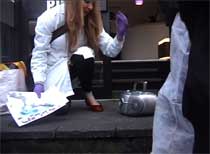
Bio-tracking: Using the GPS and Playing the sound works
How much in general do you think that the science world can learn from the art world and vice-versa?
As far as I'm concerened the "claim to truth" that science has made since the Enlightenment is really now open to question. Notions of rational empiricism seem to be under attack as unachievable. The phenomenological relationship of the experimenter to the experiment is now becoming increasingly key. The ability of art to express multiple layers of meaning, from the analytical and the philosophical to the emotional makes it an ideal method to investigate knowledge within this new paradigm, acting, I believe, as a form of meta-knowledge.
Thanks Anna!
More notes from my conversation with Antonio Cerveira Pinto, the curator of Bios 4. It's probably the first time that so many unstable art works are being shown for several months in a museum (as opposed to a few days in an art gallery during a festival) and, as Antonio notes, the experience has shown that there's a whole new relationship to be built between on the one hand, artists who use technology in their practice and on the other hand, museums which are usually wary of showing works that are not static and "quiet" like paintings are.
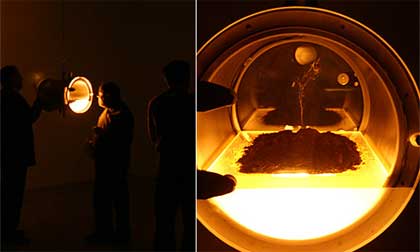
The existence of bio art, environmental art and in general new media art constitutes a challenge for museums. They have to be aware that art is evolving, and open up to new artistic forms. New expertise is needed to deal with machines and living things. Robots need to "rest", for example. Otherwise their electro-circuit dies. Museum curators and directors also have to accept that if you want to hide a computer in a sleek box just because it is "ugly", the container should be big enough to avoid any crash when the machine heats up.
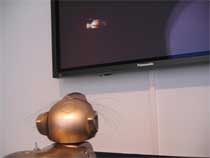
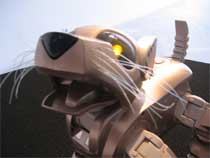
When preparing an exhibition, Antonio Cerveira Pinto likes to set up a small workshop with the museum employees, to explain them what the works are about, how the public should interact with them, what they must be cautious of, etc. I often noticed that exhibition attendants (how do you call them? guards?) seem to be quite happy when they have to keep an eye on interactive pieces. They are proud of showing you how to play with the art work, which buttons should be pushed and how, propose to take a picture of you when you play with a screen-based work, smile when they see how much kids or adults engage with the work, etc. Suddenly they have something to do, they have a knowledge to share.
Artists on the other hand, have to specify clearly how the museum has to manage and take care of the electronic, digital or living bits of their work when they are exhibited over a long period of time (as these pieces are usually shown in the context of a one-week festival). Another challenge for artists is to become experts in usability and design clear interfaces that tell visitors how to interact with their pieces.
The public too has to learn how to engage with these art pieces, adults in particular have spent decades being told "Don't touch!" "Don't go too close!", etc. Both museums and artists will have to take these challenges into account.
First image is from C-Lab's project The Martian Rose. See also their interview and the report they wrote of Bios 4.
Second set of images is from the installation Do robotic cats dream of electric fish? by France Cadet.
Thought that nothing can beat the Hulger? The Strijk-O-Foon (which i'd roughly translate as Iron-O-Phone) works only for Siemens mobile phones though. Plug the iron, wait for a call (or ring a friend) and get the Strijk-O-Foon experience in its full hot glory.
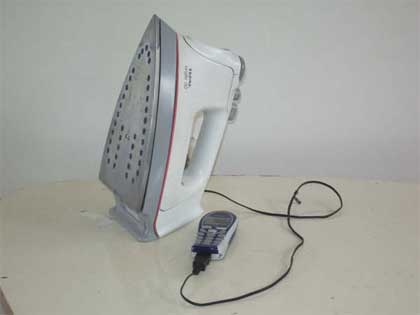
A work by Jelle de Bruijn.
Via Squeaky from.
Blogged by Hack41
. . . . . . . . . . . . . . . . . . . . . . . . . . . . . . . .

0 Comments:
Post a Comment
<< Home